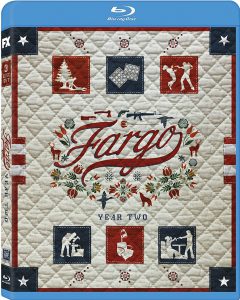Executive producer and lead writer Noah Hawley positions his chess pieces for another year of murder, crime-syndicate maneuvering and Minnes-ooh-ta accents and quirks in the premiere of “Fargo” (10 p.m. Eastern Mondays on FX) Season 2. This a brand-new story, but similar to the relationship between “Fear the Walking Dead” and its parent show, it is a prequel with loose connections to the original story. You won’t have to watch Season 1 in order to jump into Season 2 (however, you should watch Season 1 because it’s great).
The primary connection is Detective Lou Solverson. We met him as a diner owner played by Keith Carradine in the 21st-century-set Season 1 in Bemidji, Minn. In Season 2, set in 1979 in Sioux Falls, S.D., and nearby Luverne, Minn., Lou is a young detective played by Patrick Wilson; he has a 6-year-old daughter, Molly, who will become Allison Tolman’s Season 1 character. Season 2 will presumably explore why a cop becomes a restaurateur and what exactly that “Massacre of Sioux Falls” was.
The breakthrough characters are young Peggy (Kirsten Dunst) and Ed Blomquist (Jesse Plemons of “Friday Night Lights”), as both actors transform themselves into staid Midwesterners. Peggy is the striking natural beauty who wants more than simple small-town life, and Ed is the burly butcher shop employee who wants nothing more than simple small-town life. We don’t need to be told that they met in high school and love each other despite their differences. If this were set just a bit earlier, Peggy would just suck it up and not complain, and if it were set today, she would file for an amicable divorce or not have gotten married in the first place. In 1979, she’s caught in the middle.
Her longing to move to California is such that when she accidentally runs over a man (Rye, played by Kieran Culkin) who gets stuck in her windshield – whom Ed then has to kill in self-defense when the severely injured Rye lurches around their garage with a knife – she sees it as an opportunity to start a new life in California. While the idea of moving and starting over is a common trope, I find it has a more striking urgency against the backdrop of a stark, snow-covered Minnesota winter. Home is where the heart is, and all that, but there truly is something uplifting about living in a place without winter (or at least the idea of it, as we know she’ll never actually set foot in the Golden State).
For a change of pace, I’d like to see Peggy actually make it to California and get a start on that new life, but of course, subsequent episodes will find the Blomquists in Martin Freeman’s role from Season 1: Politely dodging the authorities’ questions until they are caught.
Other familiar chess pieces include the detectives, Solverson and his father-in-law Hank Larsson (Ted Danson), who are investigating the slaughter of a truck-stop diner patron, cook and waitress, which we know was committed by Rye before Peggy runs him over. The patron was a judge, and Rye – the bumbling younger brother of a Fargo, N.D., crime family, the Gerhardts – had botched his attempt to threaten her. The way Solverson and Larsson pepper in a bit of family talk as they view the crime scene is classic upper Midwest subtlety, something “Fargo” has always done so well. These guys are horrified at what they’re seeing, but it’s not in their nature to scream or cry about it, or even verbalize that it’s horrifying, as a big-city cop might do.

Other notable chess pieces: An even bigger Kansas City crime syndicate, represented by Brad Garrett’s Joe Bulo, aims to absorb the Gerhardts, by “liquidation” (murder) if necessary. And a Luverne lawyer, Karl Weathers (Nick Offerman), is the type that thinks on a deeper level than the frustrating townies he’s surrounded by (Karl likes to say “military-industrial complex”).
Season 2 doesn’t yet have a Lorne Malvo (Billy Bob Thornton in what should’ve been an awards-showered performance, if it wasn’t), and it remains to be seen if it can achieve the first year’s heights.
Still, for all its familiar tropes, Season 2 is more ambitious than Season 1. Most notably, it is set in 1979, and it gives a wonderful flavor of the recent past through the wood-paneled interiors of the Blomquist and Solverson homes, which remind me of my grandma’s home in rural North Dakota. Perhaps stepping into an older relatives’ home always feels somewhat like stepping into the past, or maybe it’s small towns that feel like the past.
More subtly, Season 2 is framed by a broader commentary on the era. It starts with pablum culled from a real-world President Carter televised speech; it’s so devoid of meaning that you can bring your own, I suppose. We also see next-prez Ronald Reagan (Bruce Campbell) take the stump, presumably ready to deliver similar pablum more effectively. What these presidents have to do with the story is unclear. Perhaps Reagan will be a figure Peggy latches onto as she dreams of California.
While I’m slightly concerned that the crime-family maneuverings and the Blomquists’ dodging of police will become rote in the wake of the movie and Season 1, there’s enough new stuff here. And frankly, Dunst’s and Plemons’ pitch-perfect performances might be reason enough to tune in, even if they are playing archetypes. Whether it breaks new ground or settles for expertly covering old ground, “Fargo” retains a spot among TV’s current elite.

